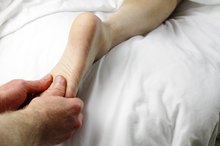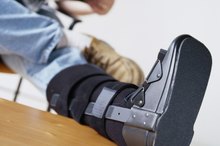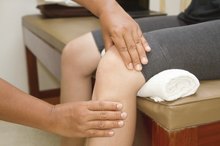Physical Therapy for a Healed Broken Ankle
Broken bones affect your ability to perform daily activities, typically requiring 4 to 6 weeks of immobilization as they heal. A broken ankle can be particularly frustrating because it also affects your ability to walk. Once the bone has healed, you may require physical therapy to improve movement and strength in your ankle, as well as your ability to walk and balance. Physical therapy may last several months, depending on your activity level prior to injury.
Range of Motion
Ankle and foot movement will likely be limited after your broken bone has healed -- particularly if you wore a cast or brace. Range-of-motion exercises are performed in physical therapy to improve ankle movement in all directions. These exercises often include lifting your foot up toward the ceiling, pointing your foot down toward the ground and rocking your foot from side to side. You might also perform ankle circles in both directions or write the alphabet in the air with your foot. Range-of-motion exercises typically begin 6 to 8 weeks after your injury.
- Ankle and foot movement will likely be limited after your broken bone has healed -- particularly if you wore a cast or brace.
- Range-of-motion exercises typically begin 6 to 8 weeks after your injury.
Strengthening
What Are the Treatments for a Torn Ligament in the Ankle?
Learn More
Muscles in your ankle and foot lose strength while your broken bone is healing. Strengthening exercises are performed in physical therapy, typically no sooner than 8 weeks after injury. Elastic exercise bands can be looped over your foot at different angles to strengthen movements in all directions -- bending your ankle up and down and rocking it side to side. Stronger bands can be used as strength improves. You might also perform foot-strengthening exercises such as picking up marbles or scrunching up a towel with your toes. Calf raises -- repeatedly raising up onto your toes while standing -- help strengthen the muscles that move your body forward when you walk.
- Muscles in your ankle and foot lose strength while your broken bone is healing.
- Elastic exercise bands can be looped over your foot at different angles to strengthen movements in all directions -- bending your ankle up and down and rocking it side to side.
Balance Activities
Broken ankle bones often affect your balance and ability to walk normally. You may have been using crutches or walking with a brace on your leg for a period of time while your ankle was healing. Your physical therapist might have you perform activities such as standing on an uneven surface or standing on one foot to improve your balance. Other balance activities include walking on your heels and toes, and standing with one foot directly in front of the other. More difficult balance exercises, such as sports-specific drills and jumping rope, might also be incorporated if your doctor has cleared you for these activities.
- Broken ankle bones often affect your balance and ability to walk normally.
- Your physical therapist might have you perform activities such as standing on an uneven surface or standing on one foot to improve your balance.
Other Treatments
How to Increase Flexibility in My Big Toes
Learn More
Physical therapy after a broken ankle might include pain-relieving treatments such as heat, ice, electrical stimulation, massage or ultrasound -- using sound waves to heat deeper tissues. Your therapist may also stretch your ankle to decrease tightness in the muscles around your ankle and the ligaments that hold your bones together. However, according to a study published in March 2010 by "The Journal of Manual & Manipulative Therapy," treatment that focuses on a progressive exercise program provides the best outcomes after ankle fracture.
Related Articles
References
- Texas Orthopaedic Surgical Associates: Ankle Fracture Treatment Guidelines
- American Academy of Orthopaedic Surgeons: Foot and Ankle Conditioning Program
- The Journal of Manual & Manipulative Therapy: Evidence-Based Treatment for Ankle Injuries: A Clinical Perspective
- Physiotherapy in Orthopaedics: A Problem-Solving Approach; Karen Atkinson, et al.
- Beckenkamp PR, Lin CC, Herbert RD, et al. EXACT: exercise or advice after ankle fracture. Design of a randomised controlled trial. BMC Musculoskelet Disord. 2011;12:148. doi:10.1186/1471-2474-12-148
- Habets B, van Cingel REH, Backx FJG, Huisstede BMA. Alfredson versus Silbernagel exercise therapy in chronic midportion Achilles tendinopathy: study protocol for a randomized controlled trial. BMC Musculoskelet Disord. 2017;18(1):296. doi:10.1186/s12891-017-1656-4
Writer Bio
Aubrey Bailey has been writing health-related articles since 2009. Her articles have appeared in ADVANCE for Physical Therapy & Rehab Medicine. She holds a Bachelor of Science in physical therapy and Bachelor of Arts in psychology from the University at Buffalo, as well as a post-professional Doctor of Physical Therapy from Utica College. Dr. Bailey is also a certified hand therapist.









